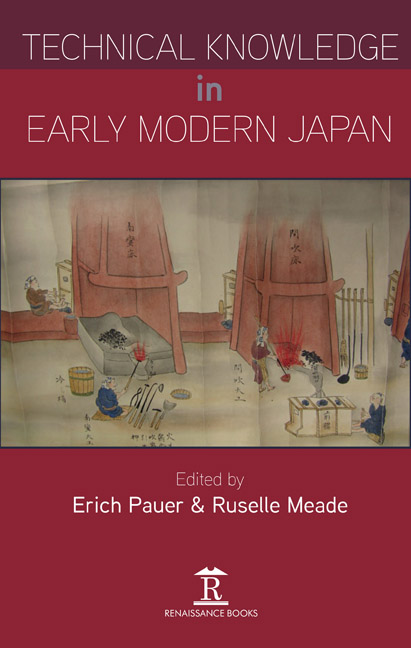Book contents
- Frontmatter
- Contents
- Acknowledgements
- Introduction: Remarks on the History of Technology in Japan
- 1 Production Techniques in Early Modern Japan as seen through ‘Famous Products of Japan from Mountain and Sea, Illustrated’ (Nippon sankai meisan zue, 1799)
- 2 Vehicles of Knowledge: Japanese Technical Drawings in the Pre-modern Era, 1600–1868
- 3 Dissemination of Knowledge and Technology: The Extensive Range of Exhibitions in Japan in the Eighteenth and Nineteenth Centuries
- 4 Knowledge on Mining and Smelting and Its Dissemination in the Edo Period
- 5 Tanaka Hisashige and His Myriad Year Clock: Its Technological Characteristics and Historical Background
- 6 A Statistical Analysis of Tōkyō Meikō Kagami (with a Focus on Highly Skilled Metalwork Craftsmen)
- 7 Boiler Manufacture in Late-nineteenth Century Japan: From First Beginnings to Nationwide Expansion
- Appendix: Selected Sources on the Japanese History of Technology (especially on series)
- List of Contributors
- Index
3 - Dissemination of Knowledge and Technology: The Extensive Range of Exhibitions in Japan in the Eighteenth and Nineteenth Centuries
Published online by Cambridge University Press: 30 April 2022
- Frontmatter
- Contents
- Acknowledgements
- Introduction: Remarks on the History of Technology in Japan
- 1 Production Techniques in Early Modern Japan as seen through ‘Famous Products of Japan from Mountain and Sea, Illustrated’ (Nippon sankai meisan zue, 1799)
- 2 Vehicles of Knowledge: Japanese Technical Drawings in the Pre-modern Era, 1600–1868
- 3 Dissemination of Knowledge and Technology: The Extensive Range of Exhibitions in Japan in the Eighteenth and Nineteenth Centuries
- 4 Knowledge on Mining and Smelting and Its Dissemination in the Edo Period
- 5 Tanaka Hisashige and His Myriad Year Clock: Its Technological Characteristics and Historical Background
- 6 A Statistical Analysis of Tōkyō Meikō Kagami (with a Focus on Highly Skilled Metalwork Craftsmen)
- 7 Boiler Manufacture in Late-nineteenth Century Japan: From First Beginnings to Nationwide Expansion
- Appendix: Selected Sources on the Japanese History of Technology (especially on series)
- List of Contributors
- Index
Summary
INTRODUCTION
THE FIRST DOMESTIC exposition organized by the Japanese government was held in Tōkyō in 1877. Despite the ongoing Satsuma Rebellion, a revolt of disaffected samurai against the new Meiji Government, the First National Industrial Exhibition was declared open by Ōkubo Toshimichi (1830–1878), the first Minister for Home Affairs, on 21 August. The launch marked the decision by the government to put greater emphasis on industry than had been the case in the first decade after the Meiji Restoration.
There were five national industrial exhibitions held during the Meiji era (1868–1912). One of the aims of holding these exhibitions was to stimulate Japanese submissions to international expositions. Exhibitors could not submit co-produced objects outside the prefecture, neither to the national exhibitions nor to international expositions, until the St. Louis Exposition in 1904. Besides the national industrial exhibitions, there were competitive exhibitions called kyōshinkai (meetings for collective advancement), which were held in the prefectures with the support of the government. These were more or less product trade fairs specializing in one category, and as such generated greater competition among craftsmen than the national exhibitions. These exhibitions gave rise to commercial museums, just as the experience of participation in international exhibitions gave rise to national museums.
The government also established schools for advanced science and technology and model factories in order to promote new industries. For example, the Ministry of Engineering founded Japan's first national technical school, the Kōgakuryō , in 1873 and Akabane Engineering Works in 1871.
However, these education measures were aimed at a young and still largely inexperienced generation of students. The new engineering factories were not intended for indigenous craftsmen. Exhibitions, on the other hand, provided a practical and immediate possibility to acquire knowledge, to then create something innovative and submit it to a subsequent exhibition. Exhibitions were a useful medium for the dissemination of new techniques.
The exhibitions may have been envisaged as a medium of dissemination, but they also proved to be a huge entertainment draw. Visitors enjoyed the technological innovations and the exotic entries, having been quite familiar with the concept of exhibitions through yakuhin-e (yakuhinkai) (medical and pharmaceutical shows) or bussan-kai (trade shows), which had first been held in the middle of the eighteenth century, and which had flourished in the first half of the nineteenth century.
- Type
- Chapter
- Information
- Technical Knowledge in Early Modern Japan , pp. 55 - 68Publisher: Amsterdam University PressPrint publication year: 2020



